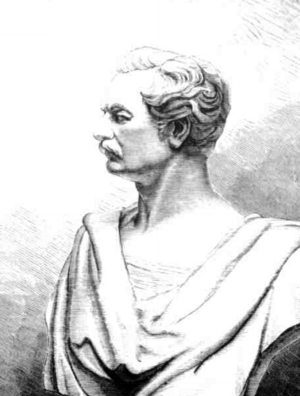Gustavus Vaughan Brooke facts for kids
Gustavus Vaughan Brooke (born April 25, 1818 – died January 11, 1866), often called G. V. Brooke, was a famous Irish actor. He was very successful in Ireland, England, and Australia.
Contents
Early Life and First Steps on Stage
Gustavus Vaughan Brooke was born in Dublin, Ireland. His father, Gustavus Brooke, had studied at Trinity College, Dublin. Gustavus went to school in Edgeworthstown and later in Dublin.
At school, he showed a lot of talent in plays. After seeing the famous actor William Charles Macready perform in Dublin in 1832, Gustavus decided he wanted to be an actor too.
In 1833, when he was almost 15, Gustavus got his first big chance. He played the part of William Tell at the Dublin Theatre. He was advertised as "a young gentleman under 14 years of age." He did well and soon played other roles like Virginius. In October 1834, he performed at the Royal Victoria Theatre in London, but it was not very successful.
Building an Acting Career
For three years, Gustavus toured theatres across England. Then, in 1837, he had a successful season in Dublin. He continued to perform in different towns in England and Ireland. In 1841, he was offered a role with Macready's acting company in London. However, he turned it down because the part was too small.
Gustavus had many successful performances in big cities like Manchester and Liverpool. He played famous characters such as Richard III, Romeo, Macbeth, Hamlet, and Othello. He even played Othello to Macready's Iago in Manchester. Later, he performed with another well-known actor, Edwin Forrest. In 1846, he played Romeo opposite Helena Faucit's Juliet in Dublin.
On January 3, 1848, Gustavus had a big success as Othello at the Olympic Theatre in London. Critics praised his acting, with some calling him one of the best actors of his time. However, Gustavus was not good at managing his money.
In October 1851, he married Marianne Bray. In December 1851, he traveled to America and had a very successful 18 months there.
Success in Australia
When Gustavus returned to England, he performed at Drury Lane. His performance as Macbeth was so good that it helped him regain his reputation. In 1854, he met George Selth Coppin, a theatre manager. They agreed that Gustavus would perform in Australia and New Zealand.
Gustavus left England on November 25, 1854. He arrived in Melbourne, Australia, on February 23, 1855. His Australian tour began three days later. He stayed in Australia for over six years. When he arrived, he knew about 40 different characters. By the time he left, he had almost doubled that number. His voice became strong again, and his acting skills improved greatly.
Many critics believed he was one of the greatest actors ever. While some roles like Romeo were less successful, he was especially good in serious plays. He also performed well in comedies and Irish roles. Gustavus's last show in Melbourne was on May 28, 1861. He then sailed back to England with his future wife, American actress Avonia Jones.
Later Life and Final Journey
Gustavus had trouble with money throughout his life. While in Australia, he tried to be more careful with his finances. He even partnered with George Coppin for a while. However, his business plans did not always work out, and he lost a lot of money.
After returning to England in 1861, he performed at Drury Lane again. But this time, his performances were not as successful, and he faced financial difficulties. In February, he married Avonia Jones.
In 1865, George Coppin, who was visiting England, offered Gustavus a new acting job in Australia. Gustavus prepared for a farewell season in Belfast. His last performance as Richard III on December 23, 1865, was very well received.
Gustavus left England for Australia on January 1, 1866, aboard the ship SS London. Ten days later, the ship sank in a terrible storm. Gustavus bravely helped pump water from the sinking ship. When there was no hope left, he was seen standing calmly. As the last lifeboat left, he called out, "Give my last farewell to the people of Melbourne." He was 47 years old.
Actor Fred Younge read a special message about Gustavus on March 17, 1866, at the Victoria Theatre, Sydney. This theatre had been the place of many of Gustavus's greatest performances.
Remembering Gustavus Brooke in Melbourne
After news of Gustavus's death reached Melbourne, members of the Melbourne Press Club decided to create a lasting memorial. They planned a series of stage performances to raise money for a statue.
They performed a play called London Assurance several times in Melbourne and other towns. They also collected donations from the public. A bust, which is a sculpture of a person's head and shoulders, was made by Charles Summers in England.
When the bust arrived, there wasn't quite enough money to pay for it. Gilbert Roberts, a theatre owner, offered to pay the rest if the bust was first shown at his Duke of Edinburgh Theatre. This happened smoothly. Later, the bust was moved to the art gallery connected to the Public Library. It was placed between busts of other famous actors, Edmund and Charles Kean.
Legacy and Influence
In the 1960s, a Canadian writer named Robertson Davies and an Australian composer named Peter Sculthorpe talked about working together. They wanted to create an opera based on Gustavus Brooke's adventures in Australia.




